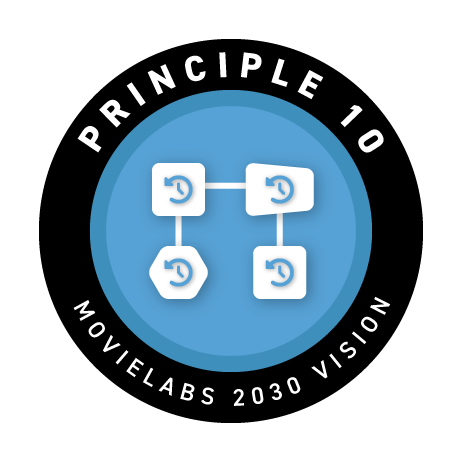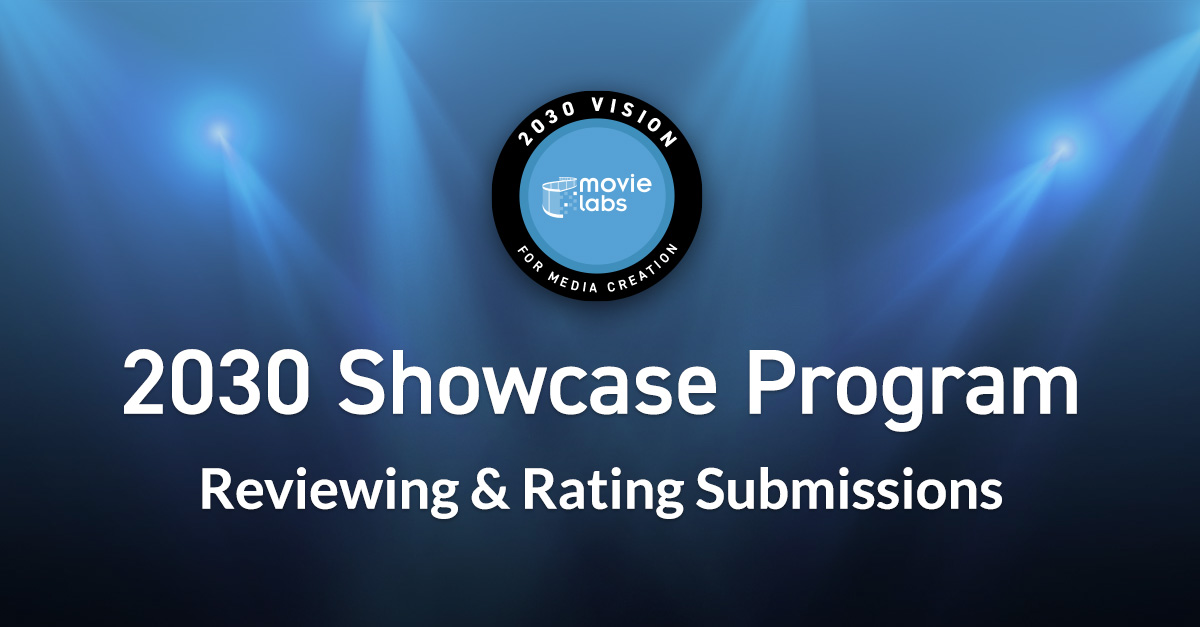We just opened submissions for the second year of the MovieLabs 2030 Showcase program. You can see the existing case studies we selected and posted last year on our website at www.movielabs.com/2030showcase. These first selections are the start of a library of learnings that MovieLabs will host featuring case studies from companies on the bleeding edge of innovation that have been willing to share their journey, their challenges, and the lessons they learned in building solutions which deliver on the 2030 Vision principles today.
While we can’t accept every qualifying submission our goal is to highlight what we believe to be the best examples of the principles being put into practice today and that will complement the rest of the case study library. As we approached this year’s showcase, we wanted to be as transparent as possible about the selection criteria we use to narrow down the list of submissions, and especially how we evaluate implementations that adopt aspects of the 10 principles. So, in this blog I’ll share what we’ve been doing to ensure that all the 2023 entrants have the opportunity to prepare their best possible submission.
The purpose of the 2030 Showcase program is to enable MovieLabs to highlight case studies from organizations, large and small, that are demonstrating delivery against the 10 principles of the 2030 Vision today. We don’t want anyone to think that the industry should wait until 2029 to deliver on the 2030 Vision, in fact we’ve seen great progress in many areas and so the Showcase program allows us to celebrate that work. However, it’s also clear that there’s more work to be done (see our upcoming blog on the current open gaps that we have identified) so let’s not try suggesting that all of the principles can be fully achieved today as that’s not yet the case.
Showcase Submission Best Practices
Before we look into how we interpret the principles, let’s just recap some best practices for the Showcase program:
- The Showcase program is not an awards program. MovieLabs does not promote or provide awards to companies or products. The Showcase highlights case studies of actual implementations with real workflows that demonstrate progress towards the 2030 Vision. So while it’s not an award ascribed to products or the companies that built them, the program is designed to share compelling examples of more efficient, secure and interoperable workflows for the benefit of the industry
- It’s not about products or companies, but about the case studies. Last year we had to decline some submissions because they didn’t contain an actual case study but rather a demonstration of how the whole company or product aligns to the 2030 Vision. While that is great to hear (and you should blog about it yourselves!!), the Showcase program is about being able to demonstrate real-world implementations of the 2030 Principles, describe the key learnings, include benefits achieved with real metrics, and show how problems were solved or new capabilities were achieved on real workflows.
- Less is sometimes more. We have 10 principles and we’re looking for alignment against one or more of them, certainly not all 10. We don’t believe that’s even possible in 2023 (see below) because to fulfill some of these principles (like Principles 5 and 6) will require an entire industry effort. So, we suggest focusing on a really deep story around a handful of principles that can be well documented rather than try and make a more tenuous case in an attempt to include more of them.
- The principles are at a high level – the real detail is in the whitepaper. We often abbreviate the 10 Principles of the 2030 Vision to make them easier to convey quickly but when assessing which principles your case study reached you should also consult the more detailed descriptions of each in the original 2030 white paper. There are also areas where we have provided subsequent material like additional whitepapers (security, software defined workflows) and blogs (ontology, interop, zero trust etc.) which are also worth studying to see how we interpret the principles themselves.
Objective Analysis
The 10 Principles of the 2030 Vision were never designed to be used as the basis of a certification program, rather, they are high level guiding philosophies, so it can be challenging even for us to objectively measure against them! But we also want to remove subjectivity wherever possible when we’re looking at case studies, so for full transparency we’re listing below what we believe are good examples of demonstrating factors for the 2030 Vision at the present moment in time. That’s important because as we get closer to 2030 we hope to raise the bar in our assessments, but at this stage we wanted to give room for features which are moving us in the right direction, even if they don’t reach the letter of the 2030 Vision just yet.










- Workflows in which all content is created or uploaded to shared cloud (public, private, hybrid) storage where applications and services can access it
- The above using systems that bridge file/object boundaries, use global namespaces, or remove boundaries between clouds, silos, and domains
- A workflow including multiple tools and services accessing content in the same storage, e.g., all of pre-production, editorial, or VFX, etc. (At this stage we feel it’s too hard for end-to-end workflows to have all applications coming to the media, but we’d like to see entire department or pipeline workflows that do.)
- High-performance, cloud-based workstations working together on shared media
- Creative applications (even via plug-ins) directly accessing and manipulating cloud assets without copying them locally. (Exemptions for caching for speed/latency, may be OK in some cases.)
- Workflows with systems using block storage to automatically cache required assets from object storage when necessary for performance and then return any changes back to object store afterwards
- Propagating assets as a publish function without moving them, using notifications (to people and/or services) and changes to access controls, if needed
- The above happening automatically upon the completion of a task
- Stretch goal – automatically removing permissions for those no longer needing access
- Storing Archive assets in the cloud with an easily searchable system that makes them an accessible library
- Other systems accessing the library to surface archive assets more broadly
- Documenting Archive rules in policies that drive automation of the archive
- Using open standards or formats that can make essence files accessible over very long time periods
- Stretch goal – The above that also makes them modifiable
- The industry wide Production User ID system posited in the paper does not currently exist, so for now we have narrowed the scope for now
- Using a single or federated identity management system with a single identity for each user across a workflow that integrates multiple vendors or a significant number of tools and services from different providers (e.g., all of pre-production, editorial, or VFX)
- The above, possibly with more than one identity used for authentication, but with all authorization policy management tied to a single common user identifier
- Implementing and using a CSAP Zero Trust Foundation for a significant workflow
- Workflow management systems changing authorization policies based on task assignment and completion
- Using a single machine-readable language for communicating authorization policies across systems
- Using asset level encryption and key management systems
- Managing assets using complex relationships to other assets, context, tasks, and participants
- Implementing the Ontology for Media Creation in a workflow
- Dynamically configuring or creating workflows based on asset inputs, outputs, or policies
- Workflows that spin up, shut down or trigger additional tasks automatically without human intervention
- Using systems to translate human readable workflows into machine readable workflows, and vice versa
- Using service meshes or messaging buses to handle notifications throughout a multi-step pipeline
- Workflow processes that used to take hours or overnight, now happening in so much faster that it changes the way work is done, for example:
- Rendering In-Camera VFX with a game engine
- Collaborating on complex visual assets in an Omniverse
- Rendering conforms with final color in real-time
- High-quality rotoscoping in real-time
- Producing dailies immediately instead of overnight
- Processing on a TV episode that used to take hours now only taking the 22-minute duration of the episode
- Fast file movers between clouds or private infrastructure
- Fast uploaders to cloud
- Cross-connect services that open up access between clouds
- Single purpose SaaS applications (e.g., cloud-based video clipping or annotation tools)
- Vendors or services downloading cloud assets, doing their work offline, and reuploading variants later
- Using local storage area networks behind a firewall or private network
- Manually notifying (e.g., sending emails) to downstream users, tasks, or services
- Manually changing permissions for publication
- Moving assets to participants performing the next task in the workflow. (Creating unique deliverables in an accessible location, e.g., a transcode required only for the next task, is OK.)
- Fast indexing of media assets, with or without AI
- Bucket-to-bucket movement of files for cost optimization across cloud tiers
- Using an organization or team identity to access cloud media/storage/services without enforcing granular access controls for individual team members
- Simply using Single Sign-On or Federated Login for some services
- Simply using the same login name across multiple identity management systems
- Workflows relying on perimeter security
- Rigid workflows using pre-determined data flows or decision making
- Using video conferencing for collaboration, e.g., remote editing with multiple collaborators
- An existing process, e.g., encoding, running faster now because of Moore’s law, but without it changing the process
- Implementation of Common Security Architecture for Production (CSAP) to help realize Principle 9.
- Implementation of the ‘Ontology for Media Creation’ as it pertains to putting Principles 8 and 9 into practice.
- Implementations of Asset or Data interchange that demonstrate interoperability in either the control plane or data plane of a workflow to help realize Principle 9.
For more information on the 2030 Showcase program and how to apply visit: www.movielabs.com/showcase-submissions. We’re looking forward to seeing your submissions for the 2030 Showcase!




